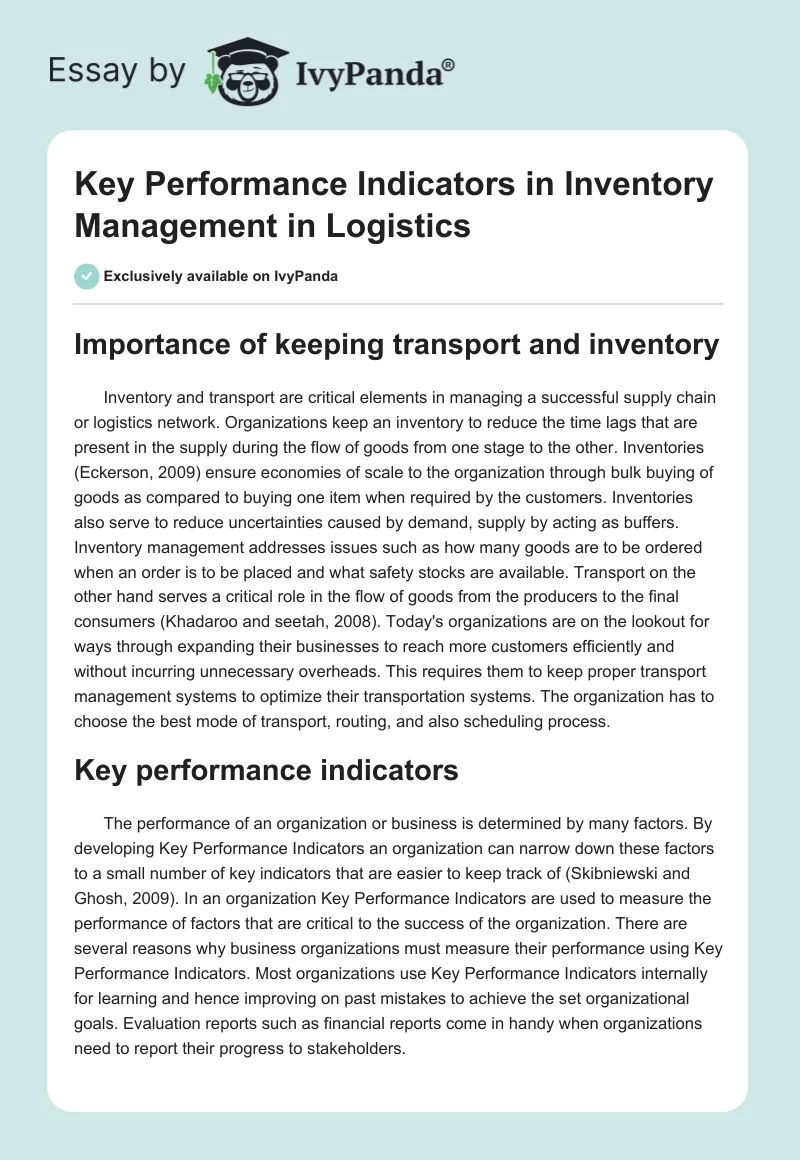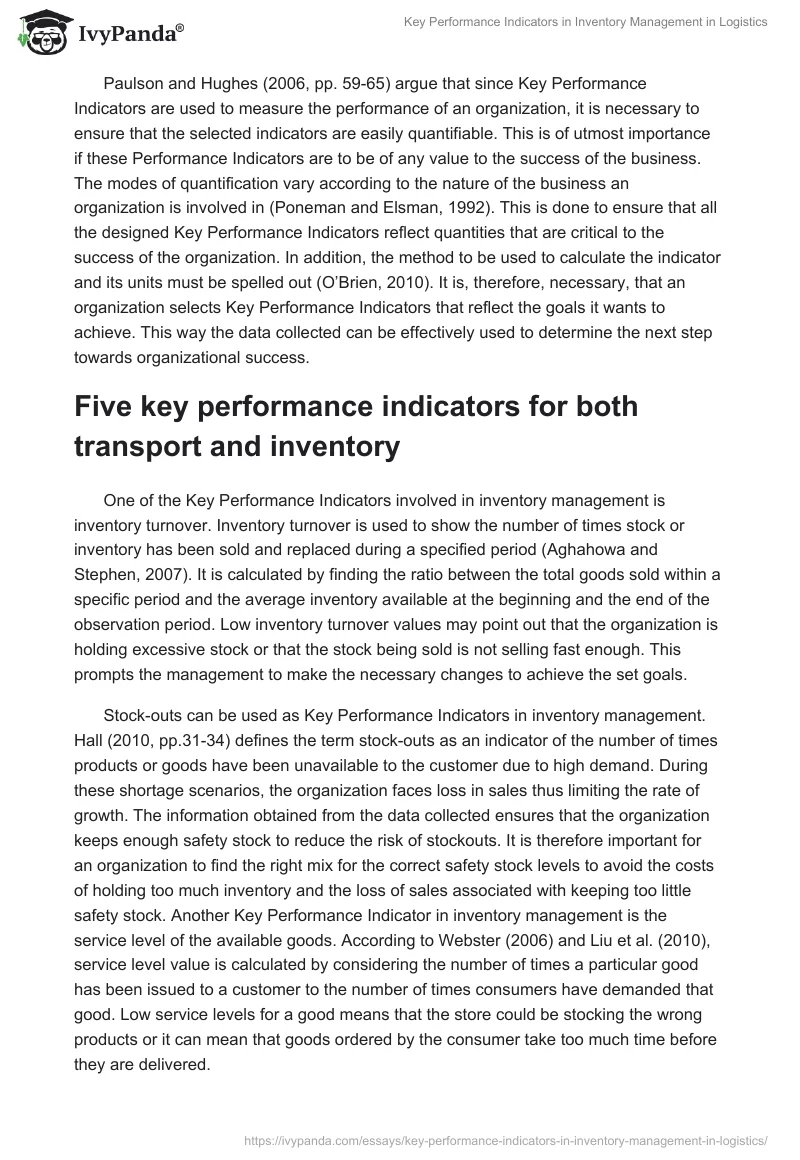Importance of keeping transport and inventory
Inventory and transport are critical elements in managing a successful supply chain or logistics network. Organizations keep an inventory to reduce the time lags that are present in the supply during the flow of goods from one stage to the other. Inventories (Eckerson, 2009) ensure economies of scale to the organization through bulk buying of goods as compared to buying one item when required by the customers. Inventories also serve to reduce uncertainties caused by demand, supply by acting as buffers. Inventory management addresses issues such as how many goods are to be ordered when an order is to be placed and what safety stocks are available. Transport on the other hand serves a critical role in the flow of goods from the producers to the final consumers (Khadaroo and seetah, 2008). Today’s organizations are on the lookout for ways through expanding their businesses to reach more customers efficiently and without incurring unnecessary overheads. This requires them to keep proper transport management systems to optimize their transportation systems. The organization has to choose the best mode of transport, routing, and also scheduling process.
Key performance indicators
The performance of an organization or business is determined by many factors. By developing Key Performance Indicators an organization can narrow down these factors to a small number of key indicators that are easier to keep track of (Skibniewski and Ghosh, 2009). In an organization Key Performance Indicators are used to measure the performance of factors that are critical to the success of the organization. There are several reasons why business organizations must measure their performance using Key Performance Indicators. Most organizations use Key Performance Indicators internally for learning and hence improving on past mistakes to achieve the set organizational goals. Evaluation reports such as financial reports come in handy when organizations need to report their progress to stakeholders.
Paulson and Hughes (2006, pp. 59-65) argue that since Key Performance Indicators are used to measure the performance of an organization, it is necessary to ensure that the selected indicators are easily quantifiable. This is of utmost importance if these Performance Indicators are to be of any value to the success of the business. The modes of quantification vary according to the nature of the business an organization is involved in (Poneman and Elsman, 1992). This is done to ensure that all the designed Key Performance Indicators reflect quantities that are critical to the success of the organization. In addition, the method to be used to calculate the indicator and its units must be spelled out (O’Brien, 2010). It is, therefore, necessary, that an organization selects Key Performance Indicators that reflect the goals it wants to achieve. This way the data collected can be effectively used to determine the next step towards organizational success.
Five key performance indicators for both transport and inventory
One of the Key Performance Indicators involved in inventory management is inventory turnover. Inventory turnover is used to show the number of times stock or inventory has been sold and replaced during a specified period (Aghahowa and Stephen, 2007). It is calculated by finding the ratio between the total goods sold within a specific period and the average inventory available at the beginning and the end of the observation period. Low inventory turnover values may point out that the organization is holding excessive stock or that the stock being sold is not selling fast enough. This prompts the management to make the necessary changes to achieve the set goals.
Stock-outs can be used as Key Performance Indicators in inventory management. Hall (2010, pp.31-34) defines the term stock-outs as an indicator of the number of times products or goods have been unavailable to the customer due to high demand. During these shortage scenarios, the organization faces loss in sales thus limiting the rate of growth. The information obtained from the data collected ensures that the organization keeps enough safety stock to reduce the risk of stockouts. It is therefore important for an organization to find the right mix for the correct safety stock levels to avoid the costs of holding too much inventory and the loss of sales associated with keeping too little safety stock. Another Key Performance Indicator in inventory management is the service level of the available goods. According to Webster (2006) and Liu et al. (2010), service level value is calculated by considering the number of times a particular good has been issued to a customer to the number of times consumers have demanded that good. Low service levels for a good means that the store could be stocking the wrong products or it can mean that goods ordered by the consumer take too much time before they are delivered.
Lead time is a Key Performance Indicator in the inventory management process of an organization. It is defined as the time interval between when an organization places an order for goods from the supplier and the time the goods arrive. By monitoring the lead times over some time an organization can stock enough goods or make orders at appropriate times to ensure that the inventory arrives at the correct time. Long lead times can force an organization to hold excess goods thus leading to a significant increase in the storage costs involved. Stock cover is another Key Performance Indicator in inventory management. Stock cover is used to refer to the period that the available inventory will last if consumption continues at the same rate. If an organization assesses the stock cover then it can make informed decisions on when to order for more stock depending on the lead time thus eliminating the possibilities of running out of inventory.
In transport management, the cost per given unit distance can be used as a Key Performance Indicator (Hall, 2010). This can be calculated by dividing the total cost for transporting goods to a particular destination by the total distance covered. High costs per unit distance can force the management to find alternative means of transport to increase transportation efficiency. Secondly, the percentage of on-time pickup or delivery of requested goods can be used by an organization as a Key Performance Indicator of the transportation system. Late deliveries of goods to clients can lead to loss of sales or increased inventory costs during storage. An organization can choose the distributor with the highest percentage of on-time pickup and deliveries thus maximizing the number of deliveries made on time.
An organization can consider claims percentage of the total freight costs as a Key Performance Indicator of its transportation system. This value can be attained by dividing the total loss due to damage to goods being transported by the cumulative freight costs (Nigrini and Johnson, 2008). High percentages show the need to introduce better handling techniques to reduce the losses. An organization can set a particular target and use this KPI to estimate whether it is achieving its goal.
Empty running is another transport Key Performance Indicator in the management of transport. This term is used to refer to the total time the vehicle is moving around empty with no inventory onboard (Aghahowa and Stephen, 2007). It is expressed as a ratio of the empty miles to the loaded miles that the vehicle traveled with inventory on board. Vehicle time utilization is the percentage of the actual time the vehicles are used to the scheduled utilization time for the vehicles. It can be used as an effective Key Performance Indicator to monitor how effectively transport vehicles are being used.
Impact of using KPI in the business organization process
The success of an organization is determined by how carefully it selects and defines its Key Performance Indicators (Eckerson, 2009). This is because the organization will use the data obtained from the Key Performance Indicators to measure their progress towards achieving set organizational goals. Shapiro and Wagner (2009, pop.161-173) found out that if the measured indicators point at the elements critical to the success of the organization then the decisions made after analyzing the data obtained will push the business closer towards achieving its goals. Key Performance Indicators allow an organization to measure the particular factors that are critical to the success of the business.
An organization can use the data obtained from results obtained from Key Performance Indicators for several purposes. According to (Onwubolu and Dube, 2006) one main use of the collected information is for learning and improvement purposes within the organization. These Key Performance Indicators allow the management to make better-informed decisions on what changes need to be done to the existing organizational process… Key Performance Indicators are also used to provide necessary progress information as demanded by the organization’s stakeholders. One good example of such a performance indicator is the annual financial statements or environmental impact assessment reports. Key Performance Indicator results can be used by the top management of an organization to guide and control how employees act within the organization to improve operational efficiency within the organization.
Federal Aviation Administration (FAA) is a United States organization that aims at providing both safe and efficient aerospace systems in the world. To assess their progress towards achieving these goals FAA has designed several Key Performance Indicators that it uses periodically to assess its success rate. Two of these KPIs are the fuel consumption efficiency and the percentage of on-time arrivals for the aircraft they are monitoring (Khadaroo and Seetah, 2008). The fuel consumption efficiency checks the average amount of fuel that an airplane consumes during its transportation trips. On the other hand, on-time arrivals KPI is expressed as a percentage of the flights that arrive within 15 minutes of the scheduled time to the total number of flights scheduled to arrive. Croatia Airlines is another good example of a transportation company that checks its aircraft utilization and punctuality of flights to assess its growth towards achieving set organizational goals (Wadsworth, 2010).
Reference List
Aghahowa, E. and Stephen, A., 2007. Developing Key Performance Indicators for airport safety and security. Facilities, [e-journal] 25(7/8), pp.296-315.
Eckerson, W.W., 2009. Performance management strategies. Business intelligence journal, [e-journal] 14(1), pp.24-27.
Hall, A., 2010. KPI’s: The new measure meeting management. Corporate meetings and incentives, [e-journal] 29(8), pp.31-34.
Khadaroo, J., and Seetaah, B., 2008. Transport and economic performance: The case of Mauritius. Journal of Transport Economics and Policy, [e-journal] 42 (2), pp.255-267.
Liu, W.B. et al., 2010. The 3E methodology for developing performance indicators for public sector organizations. Public money and management, [e-journal] 30(5), pp.305-312.
Nigrini, M.J. and Johnson, A.J., 2008. Using key performance indicators and risk measures in continous monitoring. Journal of emerging technologies in accounting, [e-journal] 5(5), pp.65-80.
O’Brien, J., 2010. The value of key performance indicators. Receivables report for America’s health care financial managers, [e-journal] 25 (5), pp.6-8.
Onwubolu, G.C. and Dube, B.C., 2006. Implementing an improved inventory control system in a small company: a case study. Production, planning and control, [e-journal] 17(1), pp.67-76.
Paulson, G.K. and Hughes, S.B., 2006. Racing to success by identifying key performance drivers. Journal of Corporate Accounting & Finance, [e-journal] 20(3), pp.59-65.
Poneman, D.A. and Elsman, D., 1992. Retail economic indicators. Monthly black book, [e-journal] 42 (2), pp.11-20.
Shapiro, J. and Wagner, S.N., 2009. Strategic inventory optimisation. Journal of business logistics, [e-journal] 30(2), pp.161-173.
Skibniewski, M.J. and Ghosh, S., 2009. Determination of key performance indicators with enterprise resource planning systems in engineering construction firms. Journal of construction engineering and management, [e-journal] 135 (10), pp.965-978.
Webster, J., 2006. Fundamental finance: Retail performance measures. ICSC research review, [e-journal] 13 (3), pp.27-34.
Wadsworth, T., 2010. Top choice. Canadian Transportation & Logistics, [e-journal] 113 (8), pp.18-27.


